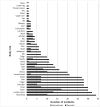Injury incidence within male elite New Zealand cricket from the early T20 era: 2009-2015
- PMID: 34868632
- PMCID: PMC8606773
- DOI: 10.1136/bmjsem-2021-001168
Injury incidence within male elite New Zealand cricket from the early T20 era: 2009-2015
Abstract
Objectives: This study aimed to describe the injury epidemiology of domestic and international level male New Zealand cricketers from seasons 2009-2010 to 2014-2015 across all match formats given the increasing popularity of T20 cricket.
Methods: Match exposure and injury surveillance data collected prospectively by New Zealand Cricket was analysed using international consensus recommendations for injury surveillance and reporting in cricket. Relationships between playing level, role and injury were statistically analysed.
Results: A total of 268 elite male New Zealand cricketers from seasons 2009-2010 to 2014-2015 were analysed from the New Zealand Cricket injury surveillance system. Total new match injury incidence rates were 37.0 and 58.0 injuries per 10 000 player hours in domestic and international cricket, respectively. Total new and recurrent match injury incidence in international cricket was approximately 1.7 times higher than domestic cricket (277.6 vs 162.8 injuries per 1000 player days). Injury prevalence rates were 7.6% and 10.0% in domestic and international cricket. The hamstring (8.2%) in domestic cricket and the groin (13.5%) in international cricket were the most injured body sites. Most match days lost in domestic cricket were to the lumbar spine (417 days), and groin in international cricket (152 days). There were statistically significant differences in injury between domestic and international level cricketers (χ2=4.39, p=0.036), and playing role (χ2=42.29, p<0.0001).
Conclusions: Total injury incidence rates in elite New Zealand cricket increased in 2009-2015 compared with previous data. International-level players and pace bowlers were the most injured individuals.
Keywords: cricket; epidemiology; injury; sport.
© Author(s) (or their employer(s)) 2021. Re-use permitted under CC BY-NC. No commercial re-use. See rights and permissions. Published by BMJ.
Conflict of interest statement
Competing interests: None declared.
Figures


Similar articles
-
Incidence and prevalence of elite male cricket injuries using updated consensus definitions.Open Access J Sports Med. 2016 Dec 13;7:187-194. doi: 10.2147/OAJSM.S117497. eCollection 2016. Open Access J Sports Med. 2016. PMID: 28008292 Free PMC article.
-
Injury in elite New Zealand cricketers 2002-2008: descriptive epidemiology.Br J Sports Med. 2014 Jun;48(12):1002-7. doi: 10.1136/bjsports-2012-091337. Epub 2012 Aug 31. Br J Sports Med. 2014. PMID: 22942169
-
Injuries in England and Wales elite men's domestic cricket: A nine season review from 2010 to 2018.J Sci Med Sport. 2020 Sep;23(9):836-840. doi: 10.1016/j.jsams.2020.03.009. Epub 2020 Mar 27. J Sci Med Sport. 2020. PMID: 32303476
-
Cricket Injury Epidemiology in the Twenty-First Century: What is the Burden?Sports Med. 2018 Oct;48(10):2301-2316. doi: 10.1007/s40279-018-0960-y. Sports Med. 2018. PMID: 30019111
-
Injuries in Cricket.Sports Health. 2018 May/Jun;10(3):217-222. doi: 10.1177/1941738117732318. Epub 2017 Oct 3. Sports Health. 2018. PMID: 28972820 Free PMC article. Review.
Cited by
-
Beyond the Boundary: A Bibliometric Analysis of the Published Research on Injuries in Cricket.Indian J Orthop. 2023 Aug 23;57(10):1575-1583. doi: 10.1007/s43465-023-00973-9. eCollection 2023 Oct. Indian J Orthop. 2023. PMID: 37766943 Free PMC article.
-
Risk Factors and Successful Interventions for Cricket-Related Low Back Pain: An Updated Systematic Review.Cureus. 2025 Mar 1;17(3):e79869. doi: 10.7759/cureus.79869. eCollection 2025 Mar. Cureus. 2025. PMID: 40166796 Free PMC article. Review.
-
A similar injury profile observed in franchise men's and women's cricket in England and Wales: injury surveillance analysis from the first three 'The Hundred' competitions.BMJ Open Sport Exerc Med. 2024 Jan 23;10(1):e001815. doi: 10.1136/bmjsem-2023-001815. eCollection 2024. BMJ Open Sport Exerc Med. 2024. PMID: 38268523 Free PMC article.
-
Exploring Injury Profiles in Non-elite Cricketers: Harnessing Online Surveys for Effective Assessment.Indian J Orthop. 2023 Sep 16;57(10):1619-1622. doi: 10.1007/s43465-023-00995-3. eCollection 2023 Oct. Indian J Orthop. 2023. PMID: 37766956 Free PMC article.
-
Quantification of Ground Reaction Forces During the Follow Through in Trained Male Cricket Fast Bowlers: A Laboratory-Based Study.Sports (Basel). 2024 Nov 22;12(12):316. doi: 10.3390/sports12120316. Sports (Basel). 2024. PMID: 39728856 Free PMC article.
References
LinkOut - more resources
Full Text Sources
